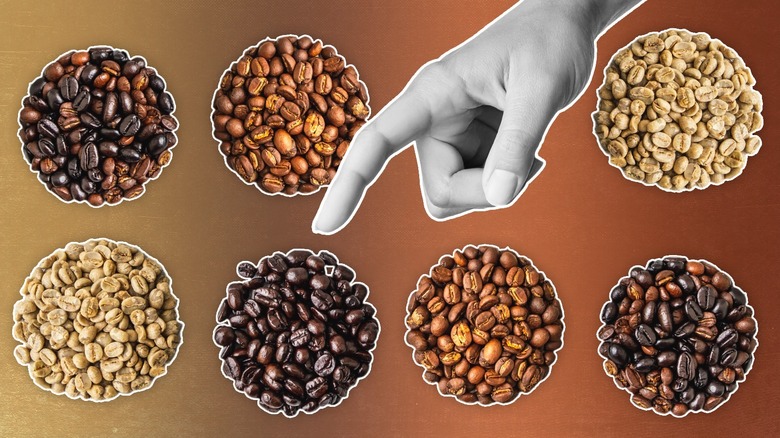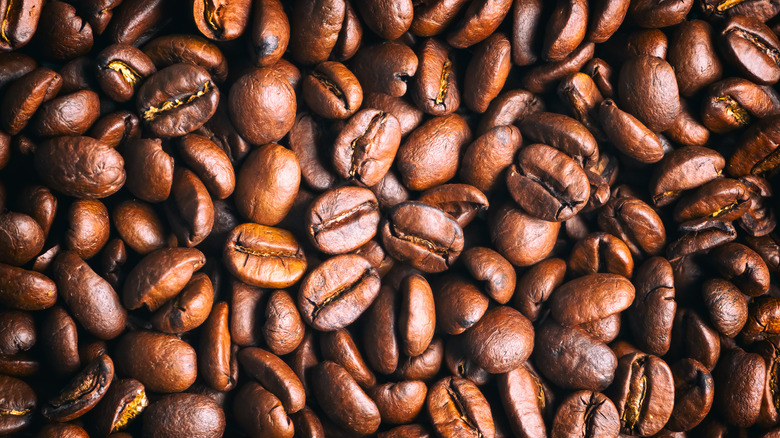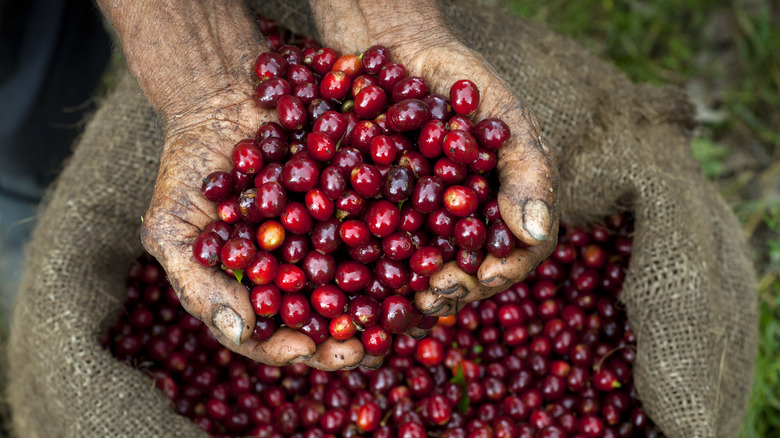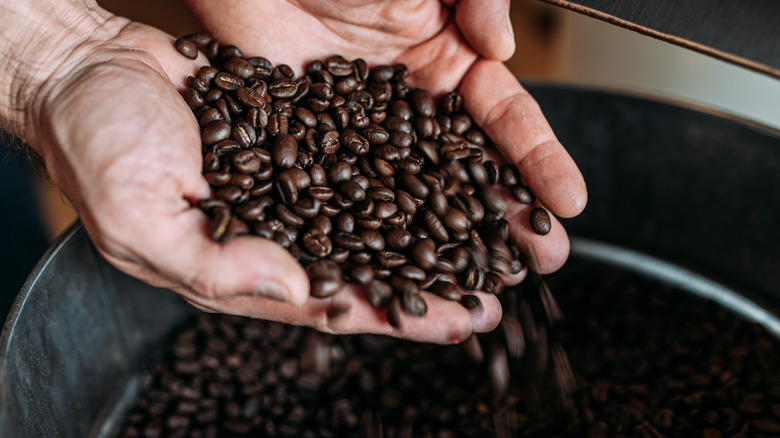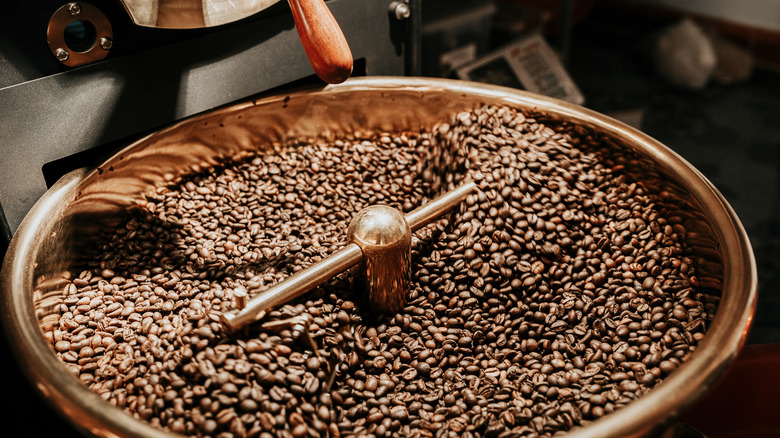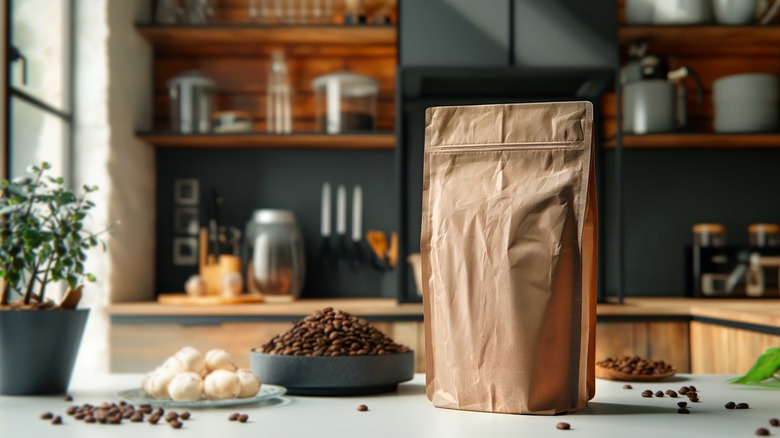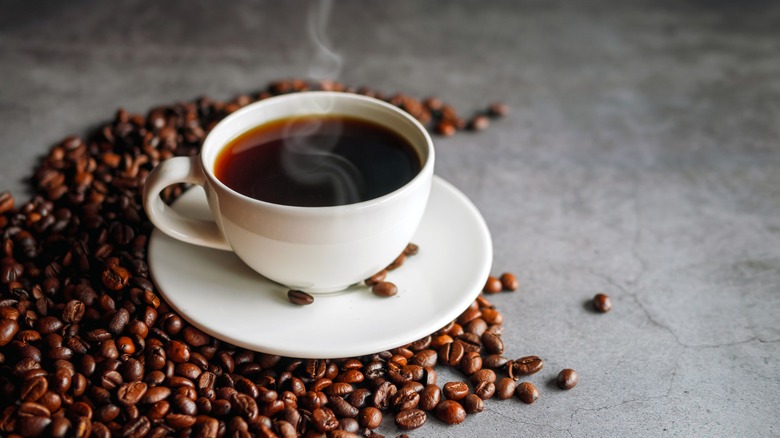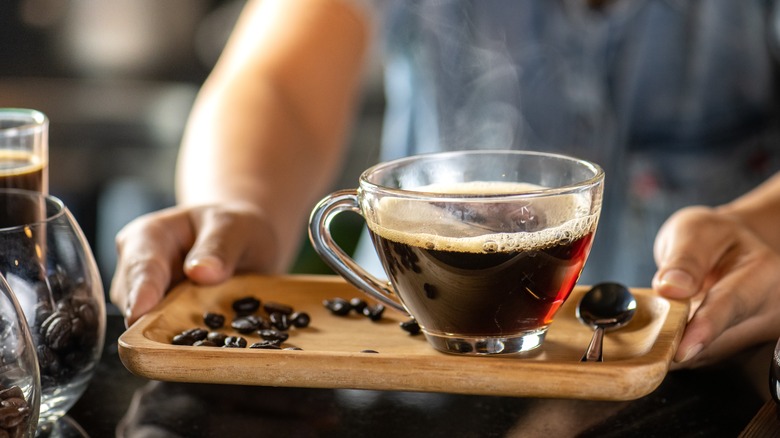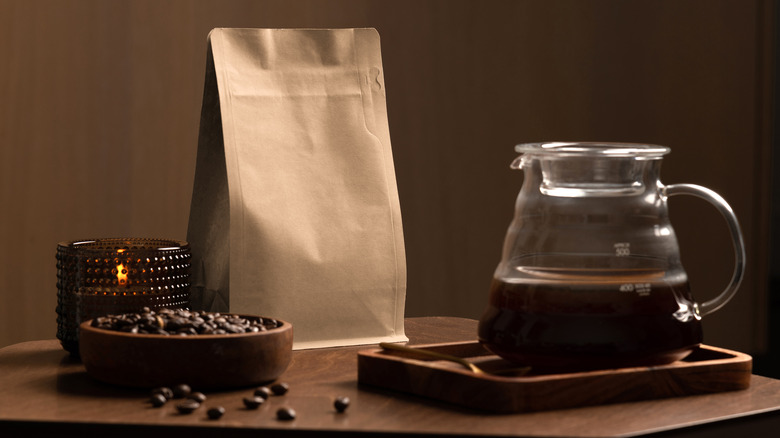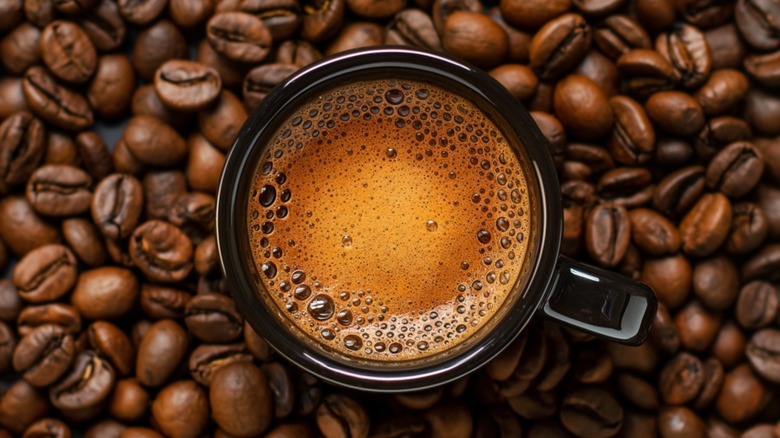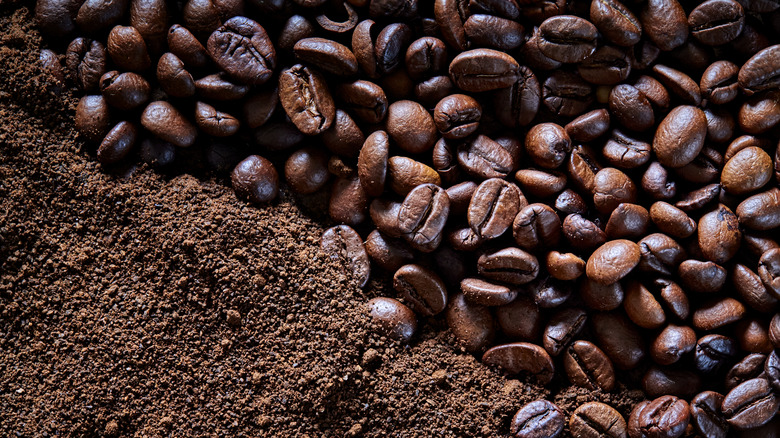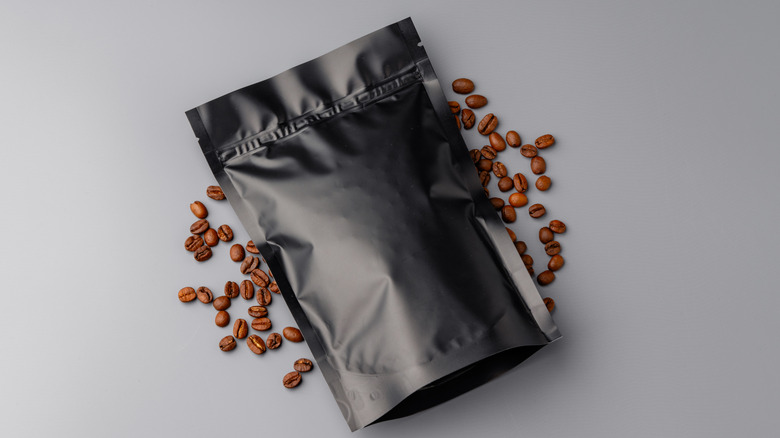11 Tips For Choosing The Absolute Best Coffee Blend
Coffee can be a daunting subject. It's easy to walk into a coffee shop and order a latte — you don't have to think about the flavor of the espresso beans or where they come from. But as you start getting more and more into the world of coffee, you gain more control over the kinds of beans you order. And if you want to find the hands-down most delicious cup of coffee you've ever tasted, well, chances are you're going to have to try at least a couple of coffee blends before you get there.
So, why choose a coffee blend in the first place? Coffee blends will generally allow you to discover more flavors within a single cup of coffee, because they combine multiple types of beans. You'll have more control over how your cup tastes — and more room to explore new flavors.
The truth is, there's no one way to pick out a single best coffee blend. That's because coffee is entirely subjective. However, as a former barista, I have some specific tips and tricks you can use to learn more about coffee and figure out what blend will be right for you. I've helped countless people find their new favorite brew. These tips will help you get ready to go out and try a few different blends for yourself.
Know the difference between light, medium, and dark roasts
If you want to find a good coffee blend, you'll first need to identify your preference for a light roast, a medium roast, or a dark roast. A light roast contains beans that have been roasted for the least amount of time compared to medium and dark roasts. Light roasts are often referred to as blonde roasts. They're slightly zestier or even fruitier than other types of roasts, and they have much less acidity. This also means that they will generally taste less bitter than the other types of roasts. The caffeine content of blonde roast is negligibly higher than that of medium and dark roast.
A medium roast, as the name implies, is in the middle of blonde and dark roasts. Medium roasts have a much more balanced flavor profile; they introduce richer flavors and more acidity to the brew, and many medium roasts tend to carry a lot of sweetness. Generally, I recommend starting with a medium roast if you're unsure of your roasting preference, then scaling it lighter or darker from there.
A dark roast will always be the richest, most powerful type of coffee blend. This is where you start to receive more acidity on your palate, which can sometimes contribute to a bitter taste. The flavor of a good dark roast is strong; sometimes nutty or chocolatey. If you prefer decaf coffee, note that many blends will also be available in decaf versions, too.
Understand Arabica versus Robusta beans
When it comes to coffee blends, you absolutely need to know the difference between Arabica and Robusta beans. These are two completely different types of coffee beans: Arabica is harder to grow while Robusta is much easier to produce. Arabica has a slightly lighter, sweeter, and more pronounced flavor profile than Robusta. Robusta, on the other hand, is less acidic but has twice the caffeine content than Arabica beans.
Generally, Arabica beans are considered ideal. High-quality coffee blends will use mostly Arabica beans in their blends, and many brands exclusively use Arabica beans for their brews. Some people also consider Arabica beans to be healthier than Robusta.
A majority of coffee lovers agree that Arabica beans just taste better than Robusta beans. For one, Robusta is so much stronger than Arabica that it can sometimes taste bitter and overpowering. But that doesn't mean that everyone prefers Arabica. Robusta beans are a highlight of many types of coffee from specific regions, such as Vietnamese coffee. Additionally, as climate change continues to affect coffee production, Robusta — a hardier plant that uses less water and is more pest-resistant — is a much more sustainable option than Arabica.
So, you don't necessarily need to knock any coffee blend that contains Robusta off your list. Robusta will often be earthier, richer, and more bitter than Arabica. In comparison, Arabica is considered light, bright, and sweeter — though each blend will have its own flavor notes within these ranges.
Understand regional variations
There are three main coffee-producing regions you need to know about when choosing a blend: Latin America, Africa, and Asia-Pacific. Every country within these regions produces different flavor of beans, so as you try more and more coffee blends, you'll want to remember more details about your favorites, like whether a blend uses mostly beans from Brazil or Ethiopia.
There are general guidelines you can follow within each region to understand what a region's beans might taste like. Latin America often features nuttier coffees. You might find flavors of chocolate and spice in Latin American beans. Africa, on the other hand, is known for floral notes, berries, citrus, and spice. Asia and the Pacific are known to have varied flavors that taste earthy and have low acidity.
Of course, these are just starting notes to help you understand what a region is most known for — this doesn't mean that every single bean from a certain region will taste the same, or even that it will have the same flavor notes. Other things can affect your blend — like the altitude at which the beans were grown, which can make them more acidic and taste fruitier. Lower elevations might produce more muted flavors. Coffee grown at lower temperatures will be stronger in flavor. Considering the terrain and understanding where beans in your blend were grown can also help you identify their flavor.
Know your blend's percentages
A coffee blend will typically feature a variety of different beans from different regions, each contributing a different flavor to the blend. Though you'll be able to tell the most prominent flavors of each blend from the notes on the blend's package, knowing the ratio of the types of coffee beans can help you understand exactly what the blend will taste like. You can also search for blends based on your favorite regions, so you'll get exactly the main flavors you want in a brew. To find a blend's bean percentage, just look on the package.
Knowing a blend's percentages is also useful if you're open to specific tasting notes but want to look for a general flavor. For example, if you know you want a more earthy-tasting coffee, you might look for blends that primarily use beans from the Asia-Pacific. Within these blends, you'll find more specific flavor profiles to choose from — spicy, sweet, herbal, nutty.
Some blends will also mix percentages when it comes to Arabica versus Robusta beans. Higher quality blends will use more Arabica beans (or all Arabica beans). Robusta beans, on the other hand, will be much stronger than Arabica beans (and contain twice the caffeine content). This can sometimes lead Robusta-only brews to being bitter, but a good blend might include some Robusta beans for extra strength and caffeine.
Don't opt for a blend containing too many beans
Generally, you'll find that coffee blends with two to three different types of beans are most common. These are a great starting point if you're looking to find your next favorite coffee blend; utilizing a few different kinds of beans will help you find a well-rounded, complex blend without it being too overpowering.
Of course, when it comes to coffee blends, two different types of beans is the minimum — or else you would just be working with a single-origin coffee (one type of bean), not a blend. But is there a maximum when it comes to coffee blends?
A lot of coffee lovers agree that five is the maximum amount of beans you should opt for when purchasing a new blend. The reason for this is because generally, you don't need more than five different types of beans to come up with a creative, flavorful blend. When coffee companies opt for more than five bean varieties, it can get confusing. Especially if you're new to the world of coffee blends, you may want to start with a blend that features just two different kinds of beans; this will help you learn to identify individual flavor notes and find your favorite flavors to look for more of in the future. Just remember that quantity doesn't necessarily equal quality when it comes to coffee blends.
Know your desired acidity level
Acidity is usually considered to be a good thing in coffee. It's the taste you get when you're drinking a full, bright, well-rounded cup — that's what helps prevent your blend from being boring. Arabica beans are more acidic than Robusta beans, so if you want a high-acidity blend, you should look for one that contains mostly Arabica beans. Light roasts have the most acidity while dark roasts have the least, so sticking with a medium or light roast might be a good choice for someone who wants a bright, acidic coffee.
However, if you want to avoid acidity for health reasons or if you just have a particularly sensitive palate, then opting for Robusta beans might actually be a good option for you. Along those lines, you could also try a dark roast blend, which will have lower acidity levels and a fuller, earthier profile.
Acidity should not taste sour; it should just taste balanced. If you're trying a blend and it's sour, well, it's probably not the acidity to blame — it could just be the blend. But having a preference when it comes to acidity isn't a bad thing, either. Most people will really enjoy an acidic cup of coffee, and I'd highly recommend trying it first so you can understand what coffee acidity is really about. But if you don't love it, know that you can opt for a slightly more muted cup of coffee.
Choose your favorite flavors
Coffee blends are a highly individual thing — or else I would just write down the name of a single coffee blend and call it a day! The fun part about coffee blends is that they give you room for exploration when it comes to coffee flavors.
Are you a big fan of citrus or floral flavors? Maybe you want a blend that features beans from Ethiopia. Can't get enough of chocolate? Beans from Columbia could be a good starting point. You can find so many flavors — all of which will vary by region and how the beans were grown and processed — within a single blend.
If you know a flavor you want to seek out first, you can look for it specifically in a coffee blend. Coffee blends will identify a few main flavors on their packaging that you can look for. This will ensure that you'll get to try a coffee blend you truly love without having to go through a lot of blends you don't.
How the beans in your blend are processed can also affect their flavor. Sometimes, the packaging will tell you this — though you can also look to the roaster or producer online for more information. If you purchase a blend with dried beans, you might find that it tastes sweeter. When beans are washed during processing, they're likely to be more acidic. Utilizing both processes will net you a mix of acidity and bright sweetness.
Try 'staple' blends first
When I think of coffee blends I'd recommend to a beginner, I usually think of blends that aren't too experimental and are considered 'basic' in flavor. Let me be clear — there's absolutely nothing wrong with having your favorite blend be a basic flavor. They're popular for a reason, after all. But these blends are also a fantastic way to try a quintessential coffee blend to get an idea of what you like.
Instead of going for a seven-layer, fruity-zesty-floral-earthy mixed blend right when you're first starting out looking for coffee blends, opt for a basic brew first — two or three beans only. I usually recommend asking your local barista what they would consider to be their shop's most basic signature blend. At larger chains, this will usually be the blend they have as a recommended or 'signature' blend — similar to how every shop will have their own signature espresso, this will be a blend the chain thinks will appeal to everyone.
Trying a staple blend will help you identify the flavors you like and don't like. It will also help you figure out which flavors you love to enjoy together — and which you really don't. When you start simple, you'll get the best introduction to the world of coffee blends. Start by asking your local barista what they'd recommend for a beginner or shopping based on a brand's best-selling blends. From there, it'll be easy to find your new favorite brew.
Don't be afraid to branch out
A lot of extremely creative, experimental blends will come from local, single-store coffee shops. Independent shops often have more room to experiment and can sometimes be focused on catering to a smaller customer base, which can give them more room to work with unique flavor profiles when compared to larger companies. If you're looking for a highly unique coffee blend or want to achieve a flavor profile that's really out-there, you should check out your local coffee shops to see if they have any recommendations for you.
This is especially true if you consider yourself more of an expert when it comes to coffee blends and are still looking to branch out even more. If you already know what you like and are trying to find a hidden gem when it comes to coffee blends, it might be hiding in your very own neighborhood.
Seasonal blends are another great way to branch out. Coffee chains big and small will often have limited-edition seasonal signature brews that are a little more experimental than their staple offerings. These can be a fun way to experiment with seasonal flavors and get a taste of a blend you might not have ever had before. The only downside of this is that you may find yourself hoarding dozens of bags of beans by the time the season ends so that you can enjoy them all year long.
Buy fresh, whole bean blends
Coffee beans will be at their peak when they are not yet ground and when they're fresh. This is why coffee chains will ground the coffee for you at the counter (if you need) rather than selling pre-ground coffee beans. That's one great way to enjoy fresh coffee if you don't have a grinder — but using a grinder at home will help your bag of coffee last even longer.
Fresh coffee beans are best enjoyed within a single week to one month of opening. When stored in an airtight container, some beans can stay fresh for a full month. But don't plan on taking your blends out of the cupboard just once every few months — enjoy them while they're fresh and consider composting once a month or two have gone by. Stale coffee beans lose their flavor. They might taste bitter or off. They might also have a bad smell or lose their aroma altogether.
This also means that, if you don't drink a lot of coffee or if you're not sure whether or not you'll like a new flavor, you should opt for a smaller bag to start. Unopened coffee blends will stay fresher for longer, so small bags might be best for anyone who isn't planning on drinking a morning brew every day.
Understand premium blends
Some blends will be marked as "premium" to guarantee that their beans are grown to the most ideal standards, which makes them taste better. Premium blends will typically feature mostly (or entirely) Arabica beans. Arabica beans generally are more aromatic, less bitter, and have more flavor, but they're also much more difficult to grow than the other strain of coffee beans, Robusta.
It's important to note that marking a coffee blend as 'premium' is not an industry standard. This means that you might find 100% Arabica beans that are extremely high-quality that aren't marked as premium. It's up to the coffee brand as to whether or not they want to mark their bags as being premium coffee. So, you shouldn't disregard a coffee blend just because it's not marked premium. Spotting a premium coffee bag can be a useful marker for quickly identifying high-quality coffee, but looking exclusively for premium coffees will mean you miss out on a lot of high-quality brews. Examine where the beans came from and what type of coffee bean a brand uses before determining whether or not it's a quality brew.
